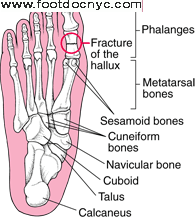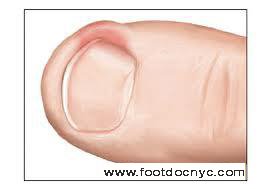Broken Toe, Foot or Ankle
By Isaac Tabari
Foot Doctors Treat Broken toe, foot or ankle
Fractures of the foot and ankle are caused by falls, twisting injuries, or direct impact of the foot against hard objects. Foot fractures are common and cause considerable pain, which is always made worse by attempting to walk or put weight on the foot.
Diagnosis is usually made by x-ray. Sometimes, computed tomography (CT) or magnetic resonance imaging (MRI) is required. Treatment varies with the bone involved and the fracture type but usually involves placing the foot and ankle in a cast. See our detailed blog post about foot fractures, their causes, symptoms and types of treatments at NYC Podiatry Center of Excellence.

Toe Fractures, or broken toes:
Toe (phalanges) fractures can occur when an unprotected foot collides with a hard object. If the big toe is abnormally bent, it may need to be realigned. Simple fractures of the four smaller toes heal without a cast. Certain measures, including splinting the toe with tape or nylon fastening (Velcro) to the adjacent toes (known as buddy taping) for several weeks and wearing loose footwear, can provide comfort and protect the toe. Stiff-soled shoes support the fracture, and wide, soft shoes place less pressure on the swollen toe. If walking in shoes is too painful, the doctor can prescribe specially fabricated boots.
A fracture of the big toe (hallux) tends to be more severe than that of the other toes, causing more intense pain, swelling, and bleeding under the skin. A big toe may break when a person drops a heavy object onto it or occasionally when a person stubs it. Fractures that affect the joint of the big toe may require surgery.
Sesamoid Fractures:
The sesamoids are two small round bones located within the flexor tendon under the big toe. These bones may fracture from running, hiking, dancing and sports involving coming down too hard on the ball of the foot (such as basketball and tennis). Using padding or specially constructed orthoses (insoles) for the shoe helps relieve the pain. If pain continues, a sesamoid bone may need to be removed surgically.
Metatarsal Fractures, or broken foot:
A stress fracture of the metatarsals (the bones in the middle of the foot) can occur when a person walks or runs excessively. Putting full weight on the foot causes increased pain. The affected area on the metatarsal bone is tender to touch. Stress fractures may not be seen on x-rays if they are small or new (in an early stage). Sometimes CT, MRI, or bone scanning shows the fracture when x-rays do not. When a developing stress fracture is recognized early, stopping activities that aggravate the fracture may be all that is necessary. In more advanced and severe cases, crutches and a cast are necessary.
A fracture and dislocation of the base of the 2nd metatarsal bone usually occurs when people fall in a way that causes the toes to bend or twist toward the sole of the foot. This injury, called Lisfranc's fracture-dislocation, is common among football players. The middle of the foot becomes painful, swollen, and tender. Lisfranc's fracture-dislocation is serious and can lead to chronic problems with strenuous activities, permanent pain, and arthritis. Surgery may be required but does not always restore the foot to its previous condition.
A fracture of the 5th metatarsal base (located at the outside edge of the middle of the foot) occurs commonly after the foot is injured by turning inward or is crushed. This fracture is sometimes called a dancer's fracture. The outside edge of the foot becomes tender, and a swollen bruise develops. The cause and symptoms may be similar to those of a sprained ankle. A cast is not usually necessary but can make walking easier. Crutches and a protective walking shoe may be needed for a few days. These fractures heal relatively quickly. Fractures of the shaft of the 5th metatarsal bone (Jones fractures) are less common than dancer's fractures and do not heal as easily.
Heel Fractures, or broken heel:
A heel fracture can occur if people land on their feet after falling from a height. Sometimes the knees, spine, or both also are injured in such a fall. Heel fractures are very painful, and people are unable to bear weight on the foot. Surgery is sometimes needed.
Ankle Fractures, or broken ankle:
The ankle may fracture when the foot rolls inward or outward during a fall or while running or jumping. Fractures usually involve the bony bump on the outside of the ankle (lateral malleolus), which is the end of the small bone of the lower leg (fibula). Less often, the bump on the inside of the ankle is involved. This bump is the end of the large bone of the lower leg (tibia). Sometimes both are affected, in which case there is usually significant ligament damage as well. Nondisplaced fractures of the ankle can be treated with a cast. Displaced fractures that can not be realigned by the doctor or held in place with a cast require surgery.
Small chip (avulsion) fractures of the ligament attachments are similar to a severe sprain. This type of fracture is treated with a brace or cast for 6 weeks and usually heals well.
***This material is only provided as helpful information and not as medical advice and you should consult with your foot doctor or another medical doctor for a professional diagnosis. ***
For more information on foot and ankle podiatry services and to make an appointment with best podiatrists at NYC Podiatry Center of Excellence, please call us at (212) 288-3137 or click below to make an appointment:

|











